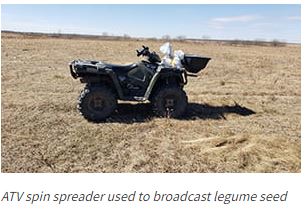
When Pasture Rejuvenation Doesn’t Pay Off
By Taylor Lenard, AAg, Range Management Extension Specialist, Tisdale
Many community pastures are situated on land that is not suited for cultivation due to unfavourable topography, stoniness, salinity or other factors limiting soil productivity. One of the biggest issues facing community pastures is the decline in productive legume species. Legumes provide a good source of protein for cattle and play an important role in nitrogen fixation for surrounding grass species. This raises the question as to how we re-introduce productive legumes into the stand without conventional farming methods. One option often considered is to overseed (broadcast) legume seed onto the soil surface.

An overseeding project was completed across four Northern pastures from 2020 to 2022. Alfalfa, cicer milkvetch, sweet clover, bird’s-foot trefoil and red clover were the species chosen for seeding. The legumes were seeded in the late summer/fall of 2020 at a rate of 1 lb./species/acre (total of 25 lb. of the mixture over five acres) using an ATV spin spreader. The mixture was seeded again on an adjacent five acres the following spring to try and account for poor weather conditions. Fields were chosen based on low existing legume counts and minimal presence of Kentucky bluegrass or creeping red fescue (bunch grasses). Over-grazing the year prior was thought to give the new seed the best chance to compete with the existing stand.
After several visits to each site throughout 2021, it was determined that there was very little (if any) new legume growth at any of the sites. It was difficult to determine the difference between the self-seeded clover versus what was intentionally broadcast as there were still some red and white clover plants in the original stand.
Rejuvenation is a pricey endeavour but one that has potential to pay off under the right circumstances. To achieve success with any type of rejuvenation you need to meet three key requirements: moisture, seed-to-soil contact and reduced competition. The limiting factor for this project was the lack of moisture. Seed-to-soil contact and reduced competition were limited because no harrowing or mechanical manipulation occurred to increase seed-to-soil contact and overgrazing didn’t hold the competition back as much as anticipated.
Overall, the rejuvenation results were not as hoped for. The dry conditions paired with the competition from the original stand made for poor growing conditions. In some places where the ground was completely bare, it allowed for a few seedlings to germinate and grow. Trying to establish legumes in an existing stand is not an easy result to accomplish in any growing condition let alone a drought year. It is important to plan ahead for your rejuvenation projects and manage your risk as much as possible.
For more information on pasture rejuvenation options, contact your local range management extension specialist or visit Beef Cattle Research Council’s website to learn more about the rejuvenation of hay and pasture.








































